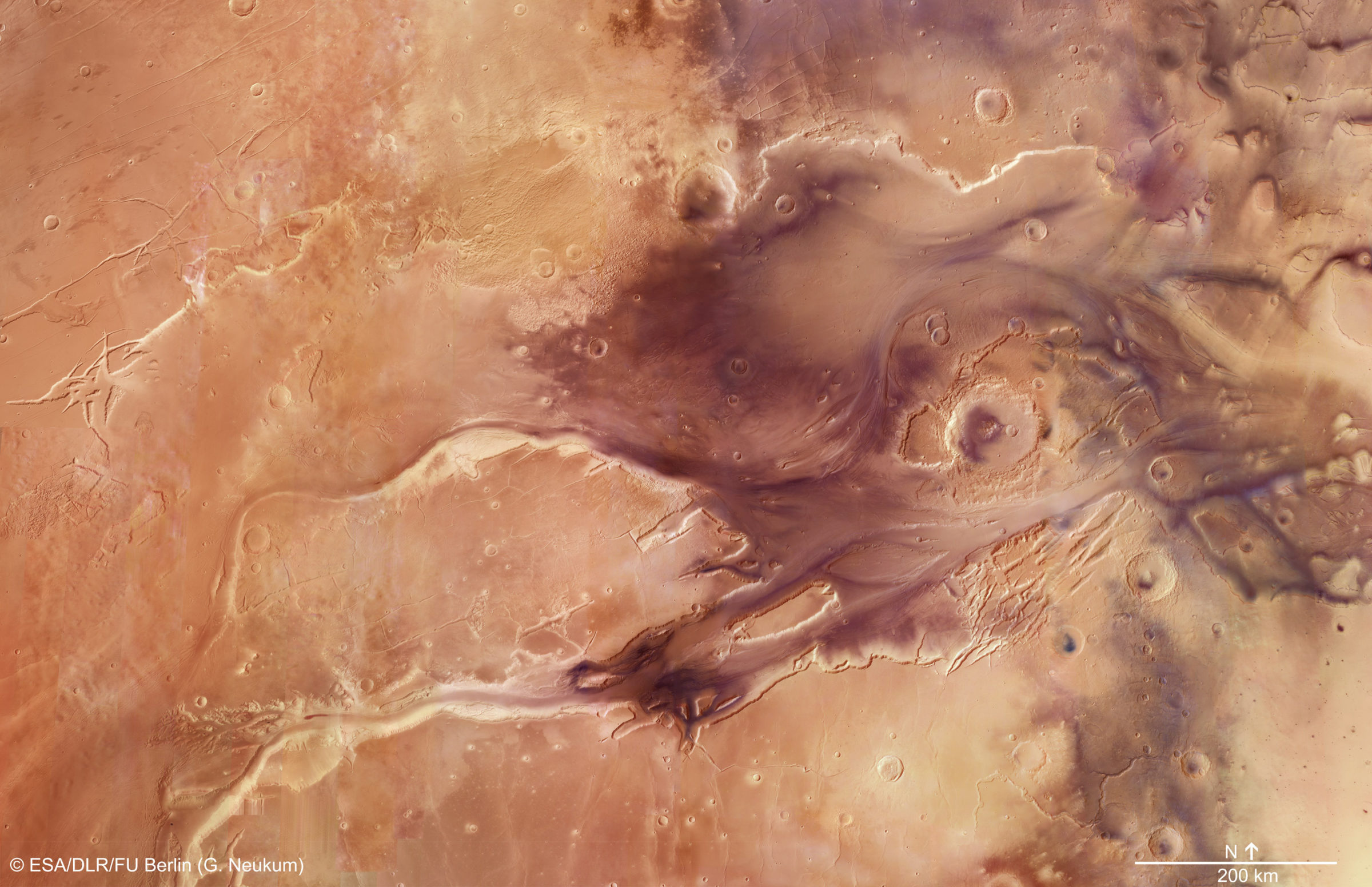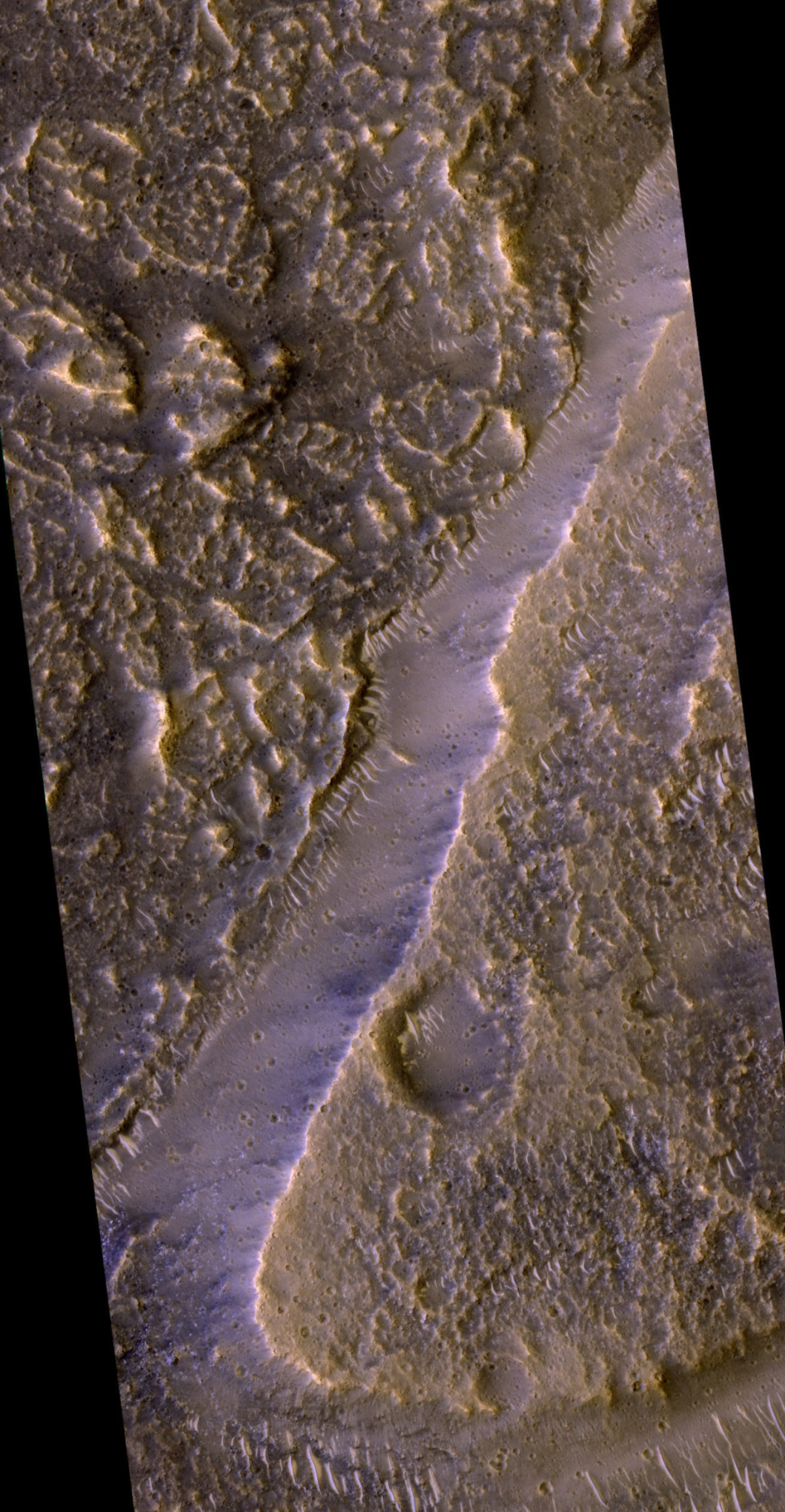Emily Lakdawalla • Jun 19, 2013
Enormously detailed photo of Kasei Valles from Mars Express
ESA celebrated the tenth anniversary of Mars Express' launch with a several-day science meeting that I was very sad not to be able to attend, coming as it did during my daughter's last week of school for the year. During that week they issued lots of press releases and numerous spectacular photos. My favorite of them all is this enormous image of Kasei Valles on Mars. The Kasei Valles are a system of Martian "outflow channels," enormous channels that dwarf water-carved features on Earth. This image covers an area about 1500 by 1000 kilometers in size (you could fit four of the rectangular state of Colorado inside it, or roughly two Ukraines).

I can't not see the head of a lambeosaurus (a crested duck-billed dinosaur) in the darker areas on the right of this photo. Pareidolia!
Because outflow channels like the Kasei Valles are so large, it's tough to find good pictures on the Internet that show most of their reach while also showing you details of their geomorphology, so this is a wonderful contribution by ESA. It doesn't quite get to the source of the southern branch, but you can see how the upper reaches (at left) curve around the plateau of Sacra Mensa. Then follow them downstream and zoom in and see the lovely braided texture of the valley floor and the way the channels diverge around other smaller plateaus (called "mensae" on Mars), leaving them as streamlined islands. When you click through the above one to enlarge, it only goes to 20 percent its full size; here's a snippet at full resolution (once enlarged). You can download the entire image at full resolution here (it's 25 MB).
Isn't it lovely?
What caused these astonishingly large channels to form? Water is only part of the story; there isn't one simple answer. Tectonics, volcanism, and glaciation probably all played a role, and the valleys are still being modified by the action of wind today. I tried to do a literature search on Kasei Valles and just got confused, so I asked a friend for a quick explanation. Here's planetary geologist Rebecca Williams' description:
In brief, Kasei was carved by catastrophic flooding. The source of the large volume of water is not well known, but some have speculated it came, in part, from Echus Chasma. Certainly multiple floods occurred, but the exact numbers are unknown. Flows were roughly the same age as other circum-Chryse outflows -- that is, Hesperian, probably Late Hesperian. [This is the middle, volcanism-dominated age of Mars' geologic history.] Although not extensively discussed in the literature, there is a 'platey' texture on parts of the floor that is likely late stage lava flows frow the west.
Echus Chasma, by the way, is about 1000 kilometers from the area pictured here, quite far to the south and slightly west; it shoots off of Hebes Chasma, which is itself a northern branch of the Valles Marineris gigantic canyon system. I dug into HiRISE data to look for that "platey" texture that she mentioned; here's one image of the platey stuff (upper left) where it stops at the edge of a plateau on the southern edge of Kasei.

One thing that always impresses me when I look at HiRISE images is how very, very old this terrain is. Seen at the Mars Express image resolution, you can imagine that water swirling around those islands yesterday. Look at it at HiRISE resolution, though, and you find that the land is decayed and decrepit, pitted by craters, scoured by wind, tracked over by sand dunes, and everywhere dusty. The events that carved these valleys were dramatic, but they happened a very, very long time ago, before there was multicellular life on Earth.
Becky went on to say "Also noteworthy is the small channel within the southern branch of Kasei Valles that is a former location of a waterfall, although this isn't easy to spot on the mosaic that you will be posting." I found two HiRISE observations of a "dry falls in the southern branch of Kasei Valles" that you can check out if you want to explore that: ESP_013297_1980 and ESP_013152_1980.
Mars Express HRSC mosaics like this one fill an important niche in our views of Mars: they are in color and high-resolution enough to reveal interesting geomorphological detail, but low-resolution and wide-angle enough that it's possible to assemble mosaics covering features as vast as Kasei Valles. The only other such color regional imagery we have of Mars is from Viking. The Viking color mosaics are still in wide use; it's about time they were supplanted with better-quality images from more modern cameras. So here is just one way that Mars Express' longevity is really paying off. I can't wait to see what other great Martian features will be treated in Mars Express HRSC mosaics.
Let’s Go Beyond The Horizon
Every success in space exploration is the result of the community of space enthusiasts, like you, who believe it is important. You can help usher in the next great era of space exploration with your gift today.
Donate Today

 Explore Worlds
Explore Worlds Find Life
Find Life Defend Earth
Defend Earth


